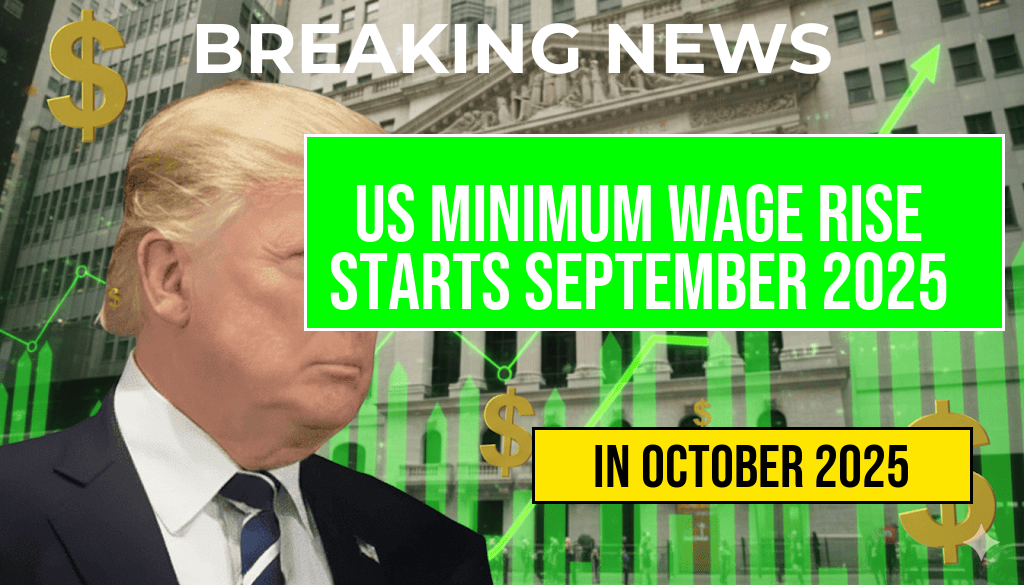The United States is set to see a nationwide increase in the federal minimum wage starting September 30, 2025, marking a significant shift in labor policies across multiple states and industries. This adjustment aims to provide essential workers with higher earnings amid ongoing debates about income inequality and economic recovery. The new minimum wage rates will vary by state and locality, reflecting regional economic conditions and cost of living differences. Workers across sectors—from retail and hospitality to healthcare—will experience these changes firsthand, with some states implementing substantial increases while others adopt more moderate adjustments. This move underscores the federal government’s commitment to ensuring a baseline income for low-wage earners, aligning with ongoing efforts to address wage stagnation over recent decades.
Details of the Minimum Wage Increase
The scheduled implementation on September 30, 2025, follows legislative and administrative processes that involved extensive negotiations at both federal and state levels. The wage hike is designed to keep pace with inflation and rising living costs, which have been a persistent concern for low-income households. While the federal minimum wage remains at $7.25 per hour, many states have set their own higher minimums, and the upcoming federal adjustment will influence these figures where applicable.
State-Level Variations and Local Policies
States with higher living costs are expected to implement more substantial increases, often surpassing the federal baseline. Some localities have established their own phased plans to gradually raise wages, while others have already adopted higher minimums in anticipation of the September 2025 change. The following table summarizes the current and upcoming minimum wages across select states:
| State | Current Minimum Wage (2024) | New Minimum Wage (2025) |
|---|---|---|
| California | $15.50 | $16.50 |
| New York | $15.00 | $16.00 |
| Florida | $11.00 | $12.00 |
| Texas | $7.25 (federal minimum) | $8.00 |
| Washington | $15.74 | $16.74 |
Many municipalities have also enacted their own minimum wage ordinances, which often surpass state standards. Cities like Seattle, San Francisco, and Boston have policies that gradually increase wages well above the federal minimum, further emphasizing regional disparities in wage standards.
Impacts on Employers and Workers
Employer Adjustments and Economic Effects
Businesses are preparing for increased labor costs, particularly in industries heavily reliant on low-wage workers. Small businesses may face challenges balancing wage hikes with operational costs, potentially leading to adjustments such as automation or reduced hours. Conversely, higher wages can boost employee morale and reduce turnover, leading to increased productivity and customer satisfaction.
Workers’ Earnings and Cost of Living
For workers earning near or below the new minimum, this change provides immediate financial relief. Households struggling with rising housing, healthcare, and transportation costs stand to benefit from higher wages, which could translate into increased consumer spending and economic activity. However, some economists warn that rapid wage hikes without corresponding productivity gains could contribute to inflationary pressures.
Legislative Context and Future Outlook
The upcoming minimum wage adjustment reflects ongoing legislative debates about the adequacy of the current federal baseline. While some policymakers advocate for a nationwide increase to $15 or higher, others emphasize regional flexibility. The Biden administration has supported efforts to encourage states and localities to set higher minimums, citing research indicating that wage increases can stimulate economic growth and reduce poverty.
Stakeholders from labor unions to business associations are closely monitoring the implementation, preparing for potential labor market shifts. Advocacy groups argue that consistent increases will help bridge income gaps, especially as inflation diminishes the purchasing power of low-income workers. Meanwhile, critics warn of possible job reductions or increased automation in sectors sensitive to labor costs.
Resources for Employers and Employees
- U.S. Department of Labor – Minimum Wage Laws
- Wikipedia – Minimum Wage in the United States
- Forbes – Impact of Minimum Wage Increases on Small Businesses
Frequently Asked Questions
What is the effective date of the U.S. minimum wage increase?
The minimum wage increase will take effect on September 30, 2025.
Which states are affected by the new minimum wage rates?
The full list of states and their new hourly rates is included in the article, covering all regions impacted by the 2025 minimum wage update.
Are there different minimum wage rates for different types of workers?
Yes, some states and localities may have variable rates based on worker categories, such as young workers or tipped employees.
How does the new minimum wage compare to previous rates?
The 2025 increase reflects an adjustment from previous rates, and the article provides a comparison chart to show the differences across states.
Will employers need to make any immediate changes to comply with the new rates?
Employers are advised to update payroll and wage policies before the September 30, 2025 effective date to ensure compliance with the new minimum wage laws.






